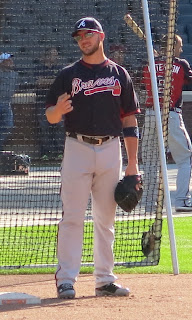 |
| By Bowman Gum [Public domain], via Wikimedia Commons |
You rarely see the same organization trade the same guy to another organization for the second time, but on this day 56 years ago, the Braves did just that. While this trade would ultimately have little significance for the Braves, the first time the team traded Dark would have large ramifications for both teams.
First, let's look at the deal in 1960. The Milwaukee Braves had acquired Dark for Joe Morgan that June. No, not THE Joe Morgan. This Joe Morgan was an 28 year-old rookie who would play just 88 games over four seasons in the majors. Dark was a three-time All-Star, but at 38, he was at the end of his rope. At the time he was picked up, Milwaukee was a couple of games behind the Pirates for the NL lead and hoped Dark would give them a veteran bat off the bench that might help them overcome Pittsburgh. While Milwaukee briefly tied the Pirates after sweeping a Sunday double header at Wrigley in late July, the Braves never pulled ahead. Of course, the Pirates would go on to play in a classic World Series that fall against the Yankees that ended with Bill Mazeroski's ninth inning moonshot off Ralph Terry.
Back to Al Dark. He hit .298/.329/.390 down the stretch for Milwaukee, which was an improvement over his 55-game run with the Phillies to open the season. The Giants wanted their former All-Star back, but not so much as a player. Soon after the Braves sent Dark to San Francisco, they named him as their manager. In his new role, Dark would win a pennant in 1962 and later won a World Series ring in 1974 as the manager of San Francisco's bay area rivals, the A's.
Like I said, the 1960 trade was the second time the Braves sent Dark to the Giants. The first time came after the 1949 season. Dark had won the Rookie of the Year award in 1948 after being paired up with second baseman Eddie Stanky as one of the top double play combos in the league. That year, Boston went to the World Series only to lose to the Cleveland Indians. However, Boston was getting older and Dark and first baseman Earl Torgeson were their only regulars under 31. The following year, Johnny Sain struggled and the offense wasn't nearly as productive as it was in '48. The Braves decided to make some moves to shake things up and in a deal with the Giants on December 14, 1949, the Braves sent their double play combo to New York for Sid Gordon, Buddy Kerr, Willard Marshall, and Red Webb. Kerr would be Dark's replacement in the sense that he played the same position, but he wouldn't replace Dark's production at the plate. The Braves banked on outfielders Gordon and Marshall helping their lineup to compensate for their weaker double play combo. While Marshall struggled, Gordon thrived and the Braves bashed their way to 148 homeruns, the most homeruns the franchise would hit in a single season before their move to Milwaukee. However, like in 1949, Boston finished fourth.
Meanwhile, Dark would excel in the Polo Grounds. After hitting just six homeruns in over 280 games with Boston, Dark hit 16 in 1950 and 87 homeruns over his first five years after joining the Giants. He would become a team captain and helped to lead the Giants to a pair of World Series trips against the Yankees in 1951 and Indians in 1954. The latter Fall Classic saw the Giants win their first title in over 20 years. Dark would later play with the Cardinals, Cubs, and the Phillies before his 1960 trade to the Milwaukee Braves.
By the way, Andre Rodgers, the guy the Braves got for Dark in 1960, was four years into an 11-year career. He never suited up for the Braves in games that count, though, and was dealt to the Cubs at the end of camp the next spring with Daryl Robertson for Moe Drabowsky and Seth Morehead. Drabowsky would become a good reliever, but long after the Braves sent him packing after one year. Morehead finished a five-year major league career with a dozen games in Milwaukee. As for Rodgers, a year after he arrived in Chicago, he was put into the lineup full-time at shortstop, which moved Ernie Banks to first base. That's a pretty cool thing to tell your grandkids.







